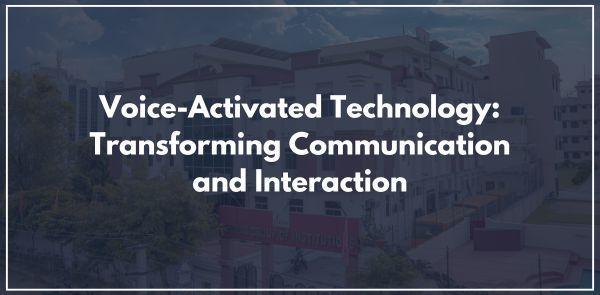
Introduction
In recent years, voice-activated technology has emerged as a revolutionary force in the way we interact with devices and systems. From smart speakers to virtual assistants, this technology is reshaping our daily lives, making tasks more convenient and efficient. As we delve into the world of voice-activated technology, we will explore its applications, benefits, challenges, and the role of educational institutions like the Poddar Group of Institutions in preparing students for careers in this rapidly evolving field.
What is Voice-Activated Technology?
Voice-activated technology refers to systems and devices that respond to spoken commands. This technology utilizes natural language processing (NLP) and artificial intelligence (AI) to understand and execute user requests. Common examples include virtual assistants like Amazon's Alexa, Apple's Siri, Google Assistant, and Microsoft's Cortana. These systems can perform a wide range of tasks, from setting reminders and playing music to controlling smart home devices and providing real-time information.
Applications of Voice-Activated Technology
1. Smart Homes
Voice-activated technology has become a cornerstone of smart home automation. Users can control lighting, heating, security systems, and appliances through simple voice commands. For instance, saying "turn on the living room lights" can instantly activate smart bulbs, enhancing convenience and energy efficiency.
2. Healthcare
In the healthcare sector, voice-activated technology is improving patient care and operational efficiency. Medical professionals can use voice commands to access patient records, schedule appointments, and even dictate notes, allowing them to focus more on patient interaction rather than administrative tasks. This technology is particularly beneficial in surgical settings, where hands-free operation is crucial.
3. Education
Educational institutions, including the Poddar Group of Institutions, are increasingly integrating voice-activated technology into their learning environments. Voice assistants can facilitate interactive learning experiences, assist students with research, and provide instant access to educational resources. This technology can also support students with disabilities, offering them greater independence in their learning processes.
4. Customer Service
Many businesses are adopting voice-activated technology to enhance customer service. Virtual assistants can handle inquiries, provide product information, and assist with troubleshooting, improving response times and customer satisfaction. This technology allows companies to offer 24/7 support, ensuring that customers receive assistance whenever they need it.
Benefits of Voice-Activated Technology
1. Convenience
One of the most significant advantages of voice-activated technology is its convenience. Users can perform tasks hands-free, allowing them to multitask and manage their time more effectively. This is particularly beneficial in busy environments, such as homes and workplaces.
2. Accessibility
Voice-activated technology enhances accessibility for individuals with disabilities. Those with mobility impairments can control devices and access information without needing to use traditional input methods like keyboards or touchscreens. This inclusivity fosters greater independence and participation in daily activities.
3. Efficiency
By streamlining tasks and reducing the time spent on manual input, voice-activated technology increases overall efficiency. Users can quickly access information, set reminders, and control devices, leading to improved productivity in both personal and professional settings.
4. Enhanced User Experience
Voice-activated technology creates a more natural and intuitive user experience. Users can interact with devices in a conversational manner, making technology feel more approachable and user-friendly. This shift in interaction style can lead to increased user satisfaction and engagement.
Challenges of Voice-Activated Technology
1. Privacy Concerns
One of the primary challenges associated with voice-activated technology is privacy. Many devices continuously listen for voice commands, raising concerns about data security and unauthorized access to personal information. Users must be aware of the privacy policies of the devices they use and take necessary precautions to protect their data.
2. Accuracy and Understanding
While voice recognition technology has improved significantly, it is not infallible. Accents, background noise, and unclear speech can hinder the system's ability to accurately understand commands. Continuous advancements in natural language processing are essential to enhance the accuracy and reliability of voice-activated technology.
3. Dependence on Internet Connectivity
Most voice-activated devices rely on internet connectivity to function effectively. In areas with poor internet access, users may experience limitations in the capabilities of their devices. This dependence on connectivity can be a barrier to widespread adoption, particularly in rural or underserved regions.

